Regulation of human penile smooth muscle tone by prostanoid receptors
- PMID: 11976264
- PMCID: PMC1762108
- DOI: 10.1038/sj.bjp.0704675
Regulation of human penile smooth muscle tone by prostanoid receptors
Abstract
We have characterized the prostanoid receptors involved in the regulation of human penile arterial and trabecular smooth muscle tone. Arachidonic acid induced relaxation of human corpus cavernosum strips (HCCS) that was blocked by the cyclo-oxygenase inhibitor, indomethacin, and augmented by the thromboxane receptor (TP) antagonist, SQ29548, suggesting that endogenous production of prostanoids regulates penile smooth muscle tone. TP-receptors mediate contraction of HCCS and penile resistance arteries (HPRA), since the agonist of these receptors, U46619, potently contracted HCCS (EC50 8.3+/-2.8 nM) and HPRA (EC50 6.2+/-2.2 nM), and the contractions produced by prostaglandin F(2alpha) at high concentrations (EC50 6460+/-3220 nM in HCCS and 8900+/-6700 nM in HPRA) were inhibited by the selective TP-receptor antagonist, SQ29548 (0.02 microM). EP-receptors are responsible for prostanoid-induced relaxant effects in HCCS because only prostaglandin E1 (PGE1), prostaglandin E2 and the EP2/EP4-receptor agonist, butaprost, produced consistent relaxation of this tissue (EC50 93.8+/-31.5, 16.3+/-3.8 and 1820+/-1284 nM, respectively). In HPRA, both prostacyclin and PGE1 (EC50 60.1+/-18.4 and 109.0+/-30.9 nM, respectively) as well as the selective IP receptor agonist, cicaprost, and butaprost (EC50 25.2+/-15.2 and 7050+/-6020 nM, respectively) caused relaxation, suggesting co-existence of IP- and EP-receptors (EP2 and/or EP4). In summary, endogenous production of prostanoids may regulate penile smooth muscle contractility by way of specific receptors. TP-receptors mediate contraction in HCCS and HPRA, while the relaxant effects of prostanoids are mediated by EP2- and/or EP4-receptors in HCCS and by EP- and IP-receptors in HPRA.
Figures
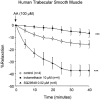
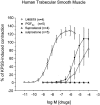
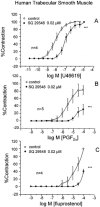

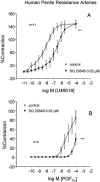

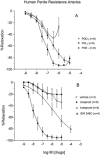
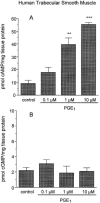
References
-
- ABRAMOVITZ M., ADAM M., BOIE Y., CARRIERE M., DENIS D., GODBOUT C., LAMONTAGNE S., ROCHETTE C., SAWYER N., TREMBLAY N.M., BELLEY M., GALLANT M., DUFRESNE C., GAREAU Y., RUEL R., JUTEAU H., LABELLE M., OUIMET N., METTERS K.M. The utilization of recombinant prostanoid receptors to determine the affinities and selectivities of prostaglandins and related analogs. Biochim. Biophys. Acta. 2000;1483:285–293. - PubMed
-
- AZADZOI K.M., KIM N., BROWN M.L., GOLDSTEIN I., COHEN R.A., SAENZ DE TEJADA I. Endothelium-derived nitric oxide and cyclooxygenase products modulate corpus cavernosum smooth muscle tone. J. Urol. 1992;147:220–225. - PubMed
-
- BUNCE K.T., CLAYTON N.M., COLEMAN R.A., COLLINGTON E.W., FINCH H., HUMPHRAY J.M., HUMPHREY P.P.A., REEVES J.J., SHELDRICK R.L., STABLES R. GR63799: a novel prostanoid with selectivity for EP3 receptors. Adv. Prostaglandin Leukotriene Res. 1990;21:379–382. - PubMed
-
- CASTLEBERRY T.A., LU B., SMOCK S.L., OWEN T.A. Molecular cloning and functional characterization of the canine prostaglandin E2 receptor EP4 subtype. Prostaglandins Other Lipid. Mediat. 2001;65:167–187. - PubMed
Publication types
MeSH terms
Substances
LinkOut - more resources
Full Text Sources
Other Literature Sources

